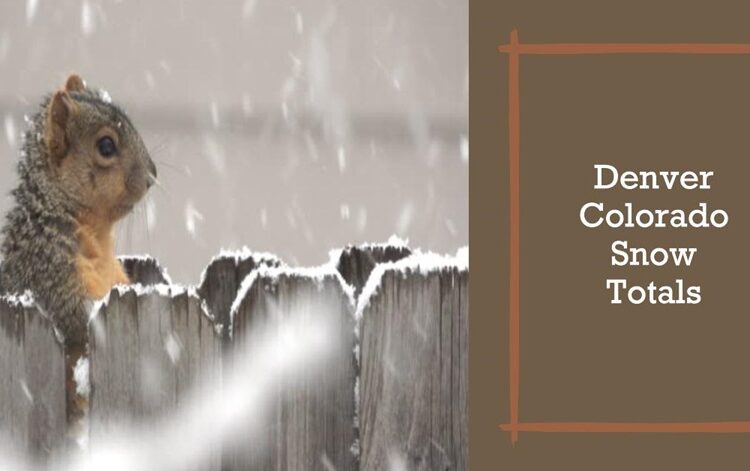Winter in Denver, Colorado, is a season that transforms the city into a picturesque winter wonderland, with the majestic Rockies serving as a breathtaking backdrop. The city’s relationship with snow is both celebrated and meticulously analyzed, as snow totals can significantly impact everything from daily commutes to the local economy and outdoor recreational activities. In this blog, we’ll delve into the historical Denver Colorado Snow Totals, understand the typical patterns of snowfall, and discuss the implications of these wintry precipitations on the city and its residents.
Denver’s geographical location at the base of the Rocky Mountains places it in a unique climatic zone, often resulting in sudden and significant variations in weather conditions. Known as the “Mile High City” due to its elevation of approximately 5,280 feet above sea level, Denver experiences a semi-arid, continental climate. This climate, coupled with its proximity to the mountains, contributes to the city’s unpredictable snowfall patterns.
Denver Colorado Snow Totals and Memorable Storms
Over the years, Denver has witnessed some remarkable snowstorms that have left an indelible mark on the city’s history. One of the most significant events occurred in the winter of 1913, when Denver was blanketed with a record-setting 45.7 inches of snow over several days. This historic blizzard brought the city to a standstill, showcasing the sheer force of nature’s wintry side.
In more recent times, the winter of 2003 saw another monumental snow event, with a March blizzard depositing over 31 inches of snow in Denver. This storm was notable not only for its snow totals but also for the speed at which the snow accumulated, causing significant disruptions to the city’s infrastructure and daily life.
Average Snow Totals and Seasonal Patterns
Despite these memorable storms, the average snowfall in Denver tells a different story. The city receives an average of around 60 inches of snow annually, with the bulk of it falling between November and March. December and March typically see the highest snow totals, aligning with Denver’s peak winter months. However, it’s not uncommon for the city to experience snowfall as early as September and as late as May, demonstrating the unpredictable nature of Denver’s climate.
Impacts of Snow on Denver
The Denver Colorado Snow Totals have a profound impact on various aspects of life in the city. For winter sports enthusiasts, the snow season is eagerly anticipated, as it transforms the nearby mountains into some of the world’s most coveted skiing and snowboarding destinations. The economic boost from winter tourism is significant, with thousands flocking to the region to enjoy the snowy landscapes and outdoor activities.
On the flip side, heavy snowfalls can challenge the city’s infrastructure and transportation systems. Denver’s public services and residents are well-accustomed to dealing with snow, from extensive road plowing to airport snow removal operations. The city’s ability to swiftly respond to heavy snowfalls is a testament to its resilience and preparedness.
Environmental and Ecological Considerations
Snow also plays a crucial role in Denver’s environmental and ecological balance. The snowpack in the surrounding mountains serves as a vital water source, feeding rivers and reservoirs that supply the city and its agriculture. The variability of snow totals from year to year can have significant implications for water availability, highlighting the importance of sustainable water management practices in the region.
Looking to the Future
As we look to the future, the question of how climate change might affect Denver’s snow totals is of increasing concern. With the globe undergoing significant climatic shifts, experts predict potential alterations in snowfall patterns that could have profound implications. These changes are not limited to mere variations in annual snow totals but could also impact the timing and intensity of snowfall events. Such shifts are likely to have wide-ranging implications, affecting water resources, winter sports, agriculture, and the overall climate resilience of the region. The dependency of the local ecosystem and the economy on consistent snowfall patterns highlights the urgency in addressing climate change and developing adaptive strategies to safeguard Denver’s future.
Conclusion
Denver’s relationship with snow is a complex and multifaceted one, intertwining historical events, seasonal patterns, and the impacts on city life and the environment. While the city’s snow totals can vary widely from year to year, Denver’s preparation and response to winter’s challenges are a testament to its resilience. As we continue to witness the Denver Colorado Snow Totals, it’s clear that snow remains an integral part of the city’s identity, shaping its culture, economy, and the natural landscape that surrounds it.
Ellen Hollington is a freelance writer who offers to ghostwrite, copywriting, and blogging services. She works closely with B2C and B2B businesses providing digital marketing content that gains social media attention and increases their search engine visibility.

